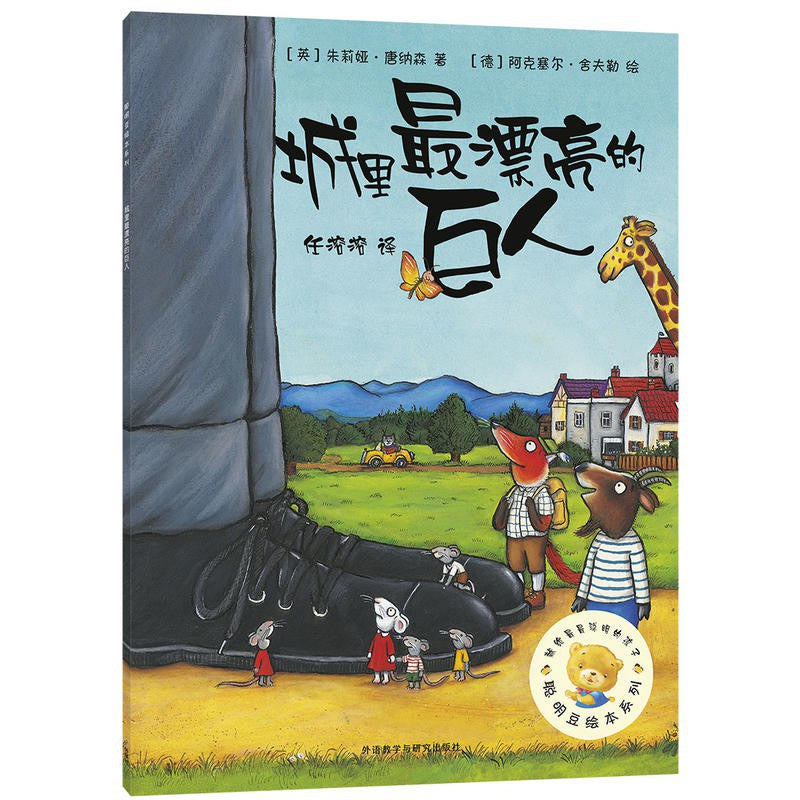WULOLIFE
《城里最漂亮的巨人》作者: (英)朱莉亚·唐纳森著 / 阿克塞尔•舍夫勒图
《城里最漂亮的巨人》作者: (英)朱莉亚·唐纳森著 / 阿克塞尔•舍夫勒图
Couldn't load pickup availability
Description
内容简介 · · · · · ·
2003 Blue Petter Award
戴金冠的邋遢大帅哥
文/梅子涵
乔治的“邋遢”
可是,有些事情,你不讲究,别人会讲究,会看不舒服。这,你只要看看书里那些人的眼神就知道了。
所以,乔治就去买衣服了,把自己打扮得漂漂亮亮,变成了城里的一个大帅哥。
有困难的长颈鹿、山羊、老鼠、狐狸、狗就纷纷出现了?帅哥没漂亮的时候他们都在哪儿呢?真是捣乱哦!
当然啦,乔治也可以什么都不给,因为谁也没有向他要。可是他还是解下领带,直到解下皮带,没有了皮带,连裤子也掉了下来,只好穿着花短裤。这哥们儿有幽默感,穿的短裤是花的!
我们要记住他唱的歌:“我的领带给受冻的小船做— —他后来一只脚跳着走,还这样唱!他真的愿意帮助人,他就会这样快乐。一个人,如果真是愿意帮助别人,那么这快乐可能会是抑制不住的。
我们要理解乔治最后只能穿着花短裤单脚跳时的难过,因为穿着花短裤穿街走巷不但的确不文明,而且也的确冷。
乔治的条纹领带给长颈鹿当围巾,衬衫给山羊的小船当船帆,鞋子给老鼠一家当房子,袜子给狐狸当睡袋,皮带铺在泥泞的地上就是一条出色的小路。——作家想得是那么合乎!合乎动物的特点,合乎东西的特点。因为合乎,就真实!就使我们一点儿看不见在有些童话里看见的“胡说八道”。写童话,每一笔都合乎很重要。因为童话容易和胡说八道混在一块儿。
最不讲究的巨人,最漂亮的巨人,最好心眼儿的巨人;因为乔治是一个最好心眼儿的巨人,所以他归根结底要把自己的漂亮都送给别人,所以他归根结底又成为一个一双棕黄色的旧凉鞋、一件打补丁的旧袍子的最不讲究的巨人。可是这个最不讲究的巨人是有金冠的!
一个戴着金冠的人,即使只穿着旧凉鞋、旧袍子,同样还是漂亮!
《城里最漂亮的巨人》—— 交织的图像趣味
(文/李茵茵 台湾台东大学儿童文学研究所博士)
打开封面、封底,这一个跨页就是一个完整的故事,角色从书中的章节片段中跳脱出来,在彼此的互动中为图画书埋下伏笔,也仿若故事线的延续。你能看出这些人物彼此的关系吗?仔细看,动物们的眼神如同箭头,将重心投注在中间的巨人身上。有趣的是,那一双拉长的脚的确凸显了巨人的大与神秘;而那只被衣服困住的兔子愤怒的眼神和颤动的胡须又为“巨大”写下了不同的注解。
阿克塞尔·舍夫勒习惯在扉页用圆形的投影当背景映衬出主角的故事。这幅图可以看出巨人穿着破旧的衣服,弯着腰、驼着背、嘴角紧闭没有笑容、无精打采的走进故事中。
大约19世纪,巨人与童话故事出现在儿童文学中。你注用图画重新演绎:首先巨人来到城里发现喷水池旁穿长筒靴的猫会洗手、小美人鱼的父亲对自己的一脸不屑、小矮人因买不到衣服而吹胡子瞪眼。这一切都加深了乔治摆脱邋遢的决心。接着乔治为了帮助动物而脱下美丽的衣服——在每一件东西改变功用后,乔治都有了新的发现,直到他找回自己——从扉页到故事的最后一页,乔治的嘴角弯成了一道弯弯的月亮。
这本书最妙的是你可以在图画中找到阿克塞尔安插的小线索与趣味。你发现了吗?在乔治回家的途中遇到许多童话中熟悉的角色映衬出他的不同及改变:像是自顾赶路的小猪、等金蛋的杰克和快乐助人的乔治;穿着华贵服的青蛙王子及送出鞋袜边跳边唱的乔治;抱着羊毛转身离去的绵羊和风中瑟瑟发抖的乔治;当然还有穿回旧衣服却早已不同于从前的乔治。
在图画的演奏中,阿克塞尔掌握了文学性、音乐性、艺术性及浓浓的趣味性。这是一本值得品味再三的图画书。
作者简介 · · · · · ·
朱莉娅·唐纳森(Julia Donaldson)
英国著名作家。朱莉娅在正为儿童电视深受孩子们的喜爱。到专职童书创作之余,朱莉娅也经常访问学校与图书馆,为小读者讲故事或表演她的作品。
目前,朱莉娅与她的先生、三个儿子定居于苏格兰的格拉斯哥。
阿克塞尔·舍夫勒(Axel Scheffler)
1957插画既优雅又诙谐,生动灵活的图像语言充满了意在言外的阿克塞尔的插画如同在演奏,文学性、艺术性、音乐性和浓浓的趣味性在他的画笔下和谐地跳跃着。目前,阿克塞尔定居英国伦敦。
任溶溶
我国著名翻译家、儿童文学作家。任溶溶通晓英、俄、意、日四种外语,翻译过许多外国著名的儿童文学作品,如安徒生童话、格林童利童长袜子皮皮》等等,创作了《“咕咚”来了》、《没头脑和不高兴》等风趣、幽默的故事。
任溶溶在儿童诗、韵文故事的翻译方面,造诣深厚。译文不仅保留了原文的内容、结构和意境,而且力求切合中国儿童的特点和理解水平。该系列图画书的翻译保持了任溶溶一贯的文字风格,琅琅上口,饶富韵味,为小读者乐于接受。
